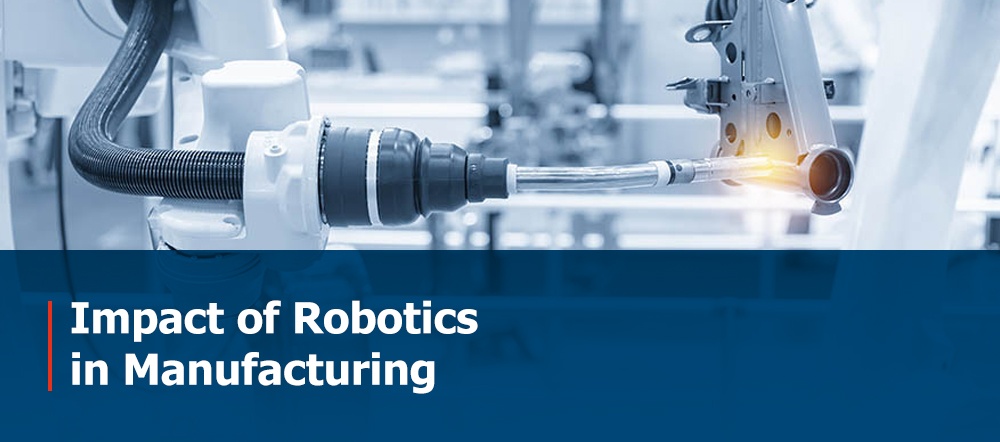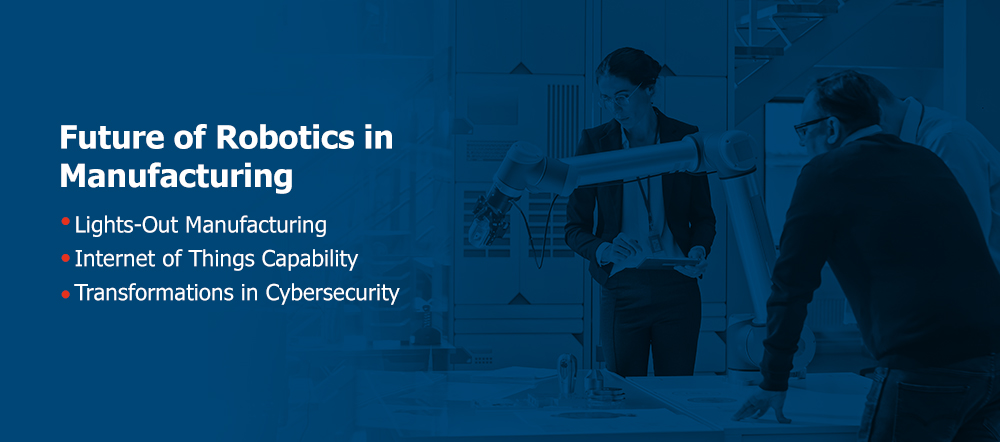In the complex and competitive world of manufacturing, where product quality and operational efficiencies are…

Robotic manufacturing systems may be a relatively new concept for some parts of the manufacturing sector, although the technology has existed for decades. By combining traditional production methods with higher forms of technology, factory managers and business owners can exponentially increase their production rates and boost their bottom line.
Robots have changed manufacturing in a myriad of positive ways. The impact of automated manufacturing spreads far and wide, improving productivity and success for the entire company. When human employees are freed from tasks that robots can easily perform, they can extend more of their energy to contributing much-needed knowledge and ideas within higher organizational roles. When implemented correctly, robotics creates an undeniable upward shift within a business’s operations.
Robot Applications in Manufacturing
Robots are used in manufacturing to take on repetitive tasks, which streamlines the overall assembly workflow. Robots also collaborate with humans for product production. Many jobs are dangerous or include high volumes of materials, which can be harmful to human workers. Even in the short-term, employees may experience fatigue or become distracted due to the repetitive nature of their work, which can cause them to make errors. Robots, however, can avoid making such mistakes because of their dexterity and high levels of machine learning.
A study from the market research company Vanson Bourne revealed 23% of unplanned downtime in the manufacturing sector occurs because of human error. This number is especially illuminating when compared to 9% of downtime in other industries. Manufacturing suffers more than most fields when it comes to human mistakes, as it’s not uncommon for one issue to slow down or stop an entire assembly line.
That is only one reason why the future of robotics in manufacturing is looking bright. For this sector, the projected demand for advanced robotics is expected to rise to $3.7 billion by 2021. This number encompasses a worldwide scale, meaning business professionals and production managers across the globe recognize the value of industrial robots. These skilled machines are evolving in ways many people could’ve only dreamed of, but like all things, they come with pros and cons.
Pros & Cons of Robots in Manufacturing
The advantages and disadvantages of manufacturing robots deserve equal consideration for the undeniable benefits these machines bring to the workplace — as well as the valid concerns. These are some of the many positive benefits that have come from using robots in manufacturing:
- A higher return on investment (ROI).
- Decreased operating and energy costs.
- Improved reliability.
- Greater precision and objectivity when performing detailed tasks.
- Better opportunities for employees to move up in the company.
Some of the biggest concerns that production managers, employees and other relevant parties have about industrial robots include:
- Increased safety risks from employees working near large, powerful robots.
- Job loss due to the elimination of certain positions.
- Limited capabilities for executing human-like tasks.
- High costs of initial robotics implementation.
- Using more time and resources to train people on working with robots.
How Robotics Are Evolving
The history of robots in manufacturing is expansive. Through the last few decades, these machines have steadily increased in their number of applications and efficiency. Though many see them as modern marvels, robotic manufacturing systems have been around for much longer. The inventor George Devol filed a patent for the first industrial robot in 1954, and the prototype came to life in 1961. It looked and functioned much like today’s robotic arms, able to carry 500 pounds and pull off tasks once thought exclusive to humans.
From there, these machine-based arms became a familiar sight in automotive factories and other manufacturing plants. Now, robots come with numerous features and capabilities that make them more unique, flexible and productive than before. Collaborative robots, or cobots, can work on the factory floor alongside humans for a faster, more efficient workflow. Many can even accommodate physical interaction, such as a worker physically adjusting the machine’s movements so it can memorize and repeat those steps on its own.
Both within and outside of the manufacturing field, robots are gaining senses such as touch and vision. These innovations make a major difference in a robot’s capabilities, allowing it to accomplish feats it couldn’t have done otherwise:
- Touch: Some recycling facilities employ robots that can identify and separate waste depending on the texture. Combining this feature with vision-based machine learning makes robots far more adept at sorting refuse than human workers, which can relieve them of the dangerous work of waste management. MIT recently created a machine that can predict what object or part of an item it is touching from tactile input alone.
- Sight: Some robots contain Light Detection and Ranging (LiDAR) sensors, which allow them to judge distances by using laser reflections. This sense is comparable to echolocation in animals like bats and dolphins — sound waves help these creatures pinpoint an object’s location. A notable example comes from FedEx’s SameDay Bots, which can navigate around people and objects using LiDAR.
- Hearing: Much like LiDAR technology and echolocation, some robots can use a form of technology called laser vibrometry to detect vibrations. This ability essentially allows them to hear basic sounds and even conversations. Although this is currently more common in consumer electronics — like smart devices — it may soon make its way to manufacturing robotics as well.
Future of Robotics in Manufacturing

What will future applications of industrial robots look like, and how can they streamline manufacturing? Here are a few ways these machines are already beginning to evolve.
1. Lights-Out Manufacturing
Lights-out manufacturing allows robots to work without any interference. This term is common among factories with few, if any, human workers — machines handle the production process from beginning to end. Some manufacturers may find this concept easier to implement than others, but those that do integrate it into their operations tend to see a marked improvement in productivity and labor costs. Companies that practice this strategy can even experience better energy efficiency because of a decreased need for climate control and additional lighting.
2. Internet of Things Capability
The Internet of Things (IoT) connects physical devices with internet applications — like cloud-based software — to make them smarter and more aware of their surroundings. Robotics manufacturers are merging the two by equipping robots with sensors that enable them to read their environment. These tools pick up on external information such as tactile and visual input. With this data, these bots can make informed decisions about what action to take next.
More advanced applications of the IoT include predictive analysis and location tracking. Integrating these abilities into existing robotics sensors can take these devices to the next level of automation. A robot that could predict another machine’s imminent breakdown — or inform production managers of its own upcoming maintenance schedule — would bring innovation on an unprecedented scale.
3. Transformations in Cybersecurity
Employing artificial intelligence and cloud-connected robotics within your business can take you beyond the competitors, but it can also make your operation more vulnerable to cyberattacks. As more companies plug into IoT-based systems, they’ll need to increase their cybersecurity measures to protect sensitive information. Enhanced cybersecurity is one of the major trends in robotics, and for plenty of good reasons.
Security responsibility primarily lies with three significant groups — the robot manufacturer, the integrator and the operator. Robotic firmware and software can be vulnerable to hacking, which means the company building the bots must install them with robust safety systems from the start.
Offensive and defensive security — which involves testing for vulnerabilities and installing protective controls — can safeguard these machines against outside interference. This tactic requires a team approach from both integrators and operators to succeed.
Contact MANTEC for Help With Advanced Manufacturing Technology
If you’re thinking of adopting a robotic manufacturing system but don’t know where to start, MANTEC can help you achieve your goal. We possess expert knowledge in advanced manufacturing technology, which allows us to assist our clients with effective technology implementation. Our clients have seen long-standing success with our consulting services thanks to our customized solutions, an abundance of internal and external resources, and expert training programs.
As the leading resource center for small to mid-sized manufacturing companies in Pennsylvania, we provide you with the highest quality service and most trustworthy knowledge. Call at 717-843-5054 or Contact us today for consultation on starting or enhancing your future in robotics.



